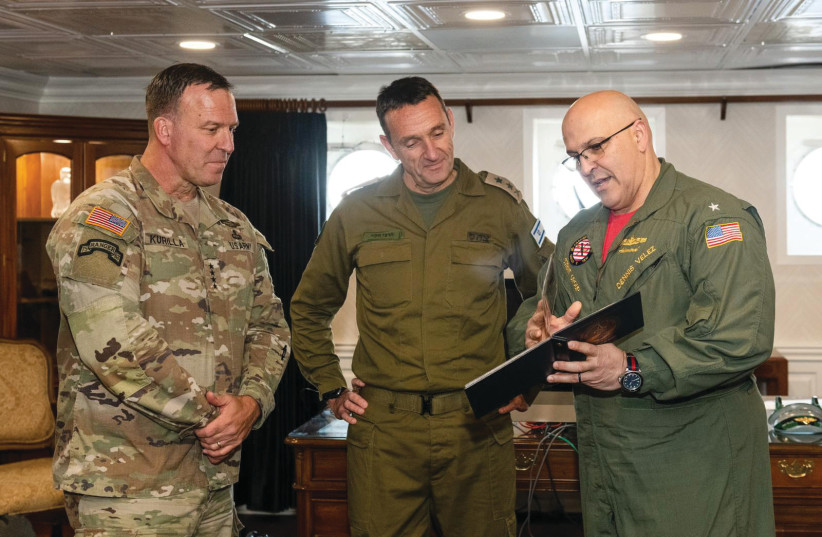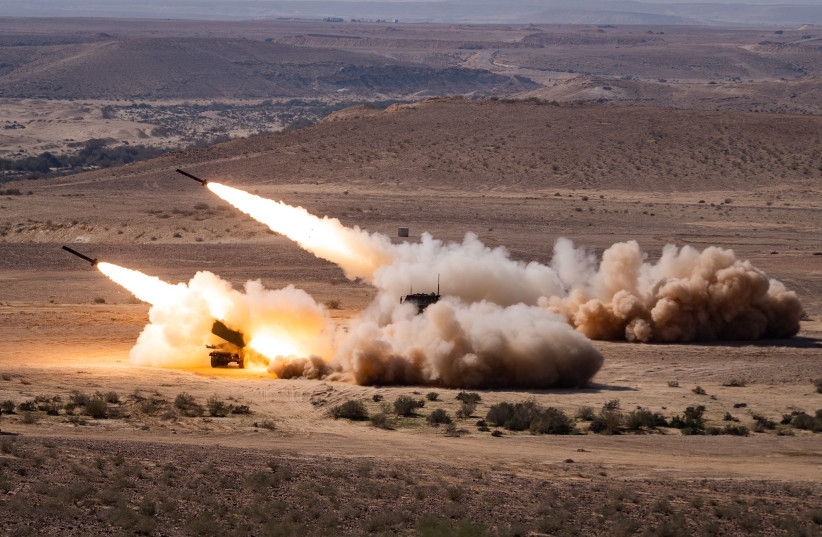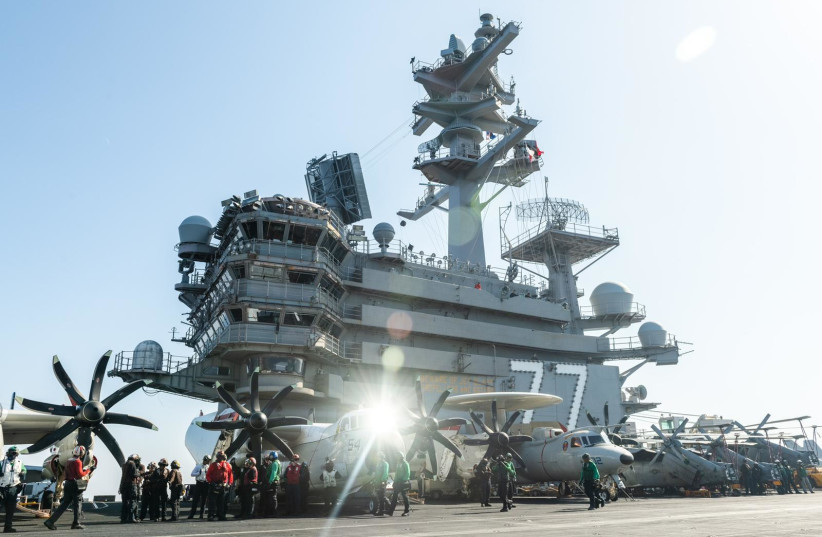White, yellow and purple fire erupted from their engines like a volcano.
The force of the explosion in their engines was deafening, even at a distance of a couple of hundred meters, and slightly shook the entire area.
Israel’s F-35 Adir elite fighter aircraft sped off one by one down the Nevatim Air Force Base runway near Beersheba, curving at first slightly to the right and then bursting forward with a stunning thrust, cutting deep rightward, as well as sailing upward at an acute angle.
After witnessing six aircraft taking off (and nearly going deaf the one time that we were too slow in covering our ears), the Magazine, a group of IDF officers, and one other media outlet turned our attention to the American F-15s that were due to take off next.
The F-35s had taken off with increments of 30 to 90 seconds in between each aircraft.
 ISRAELI AND AMERICAN train through Israeli airspace. (credit: IDF SPOKESPERSON’S UNIT)
ISRAELI AND AMERICAN train through Israeli airspace. (credit: IDF SPOKESPERSON’S UNIT)IDF Lt.-Col. M, commander of the 140 F-35 squadron, told the Magazine that the entire squadron could be up in the air during the exercise in less than 10 minutes and in an operational situation, far more rapidly.
However, the four American F-15s, even during the exercise, seemed to take off at a much faster rate – within 30 seconds or less – practically one right after another.
A Gulfstream G-500/G-550 (Nachshon) was also involved to train for intelligence collection.
Up close and on the ground, the gray F-35s, in shades of red, sported an eagle symbol and had a variety of messages written in large font on the aircraft itself.
These messages are to remind pilots and crews about proper handling of the cockpit and canopy, as well as instructions relating to items to remove before flying and various latches that need to be moved.
F-35s: A small and deadly aircraft
The F-35s seem astonishingly small for the best fighter aircraft in the world.
THEN AGAIN, as IDF Capt. I, the commander running the joint Israeli-US drill from the Israeli side, pointed out, the F-35s are made to be small and to carry fewer weapons. That is so they can have a much lower radar signature and achieve their stealth attack-with-surprise capability.
Asked about a variety of tasks, such as refueling, which might be necessary when striking distant locations such as Iran, M declined to address specific targets but said, “The Air Force would be ready for all tasks,” sending a message that the IDF has creative solutions for long-range flights.
Analysts have speculated that the IDF could use its aging Boeing 707 for mid-air refueling, even if not ideal, or that IDF aircraft might land and refuel at moderate Sunni locations in the Gulf. If an attack were to occur at some point in the future, or with US refueling assistance, Israel could use the American or its own new KC-46 refueling aircraft, which it will eventually receive from Boeing.
M was asked what he would do if he were engaged by antiaircraft missiles and if there were different maneuvers for avoiding one missile versus 10 or 30 or more.
Without revealing specific tactics, he confirmed that there were different tactics “to make sure we protect the aircraft according to different antiaircraft defense scenarios.”
In mid-December, outgoing IDF chief of staff Aviv Kohavi said that Israeli Air Force jets attacking Syria in recent years have, at times, faced 30 to 40 surface-to-air missiles or even up to 70 such missiles without losing a single aircraft.
When Kohavi’s recent quote regarding 70 antiaircraft missiles was mentioned, M said, “We know how to deal with” any scenario.
SOME ANALYSTS have noted that the aircraft that Israel possesses can also fire long-range missiles to strike targets in Iran from a significant distance, and then hightail it back to Israel while remaining out of range of Iranian defenses or while maximizing their ability to get out of range before those defenses kick in.
When presented with the idea that the IDF has had a 90% success rate in attacks in Syria against land-based targets, whereas hitting aerial targets which can maneuver in more of a three-dimensional manner, M demurred. He said, “Both land forces and hitting aerial attack drones have different challenges.”
He did not specify the different challenges. But one special challenge sometimes presented with land-based targets versus aerial targets is the proximity to potentially innocent civilians.
M would not say all the places he had flown, but there was a clear implication that with his long flight record, he would have served in missions striking targets in Syria.
At a recent graduation ceremony of Air Force personnel, then-defense minister Benny Gantz said that the graduates would need to be ready to attack Iran in “two to three years.”
Since then, outgoing chief Kohavi, new IDF Chief of Staff Herzi Halevi, new Defense Minister Yoav Gallant and Prime Minister Benjamin Netanyahu have all made direct threats to Iran about its nuclear program and regional terror.
The goal of the joint flights and simulated attacks witnessed by the Magazine was to train for hitting targets in “deep” enemy territory, often a euphemism for Iran and other countries that do not have immediate borders with Israel.
Clearly, the US is a huge asset and backer. As M said, “Any help from the US could be good” if any foreign strike were ordered, but “we do not need them or anyone else” if Israel is compelled to take action and other allies prefer to stay on the sidelines.
IN LATE January, the exercise which the Magazine partially witnessed was followed by “Juniper Oaks,” which was called the largest US-Israel joint exercise in history.
 IDF Chief Herzi Halevi (C) and US CENTCOM Commander General Michael Kurilla (L) receive a briefing. (credit: IDF SPOKESPERSON’S UNIT)
IDF Chief Herzi Halevi (C) and US CENTCOM Commander General Michael Kurilla (L) receive a briefing. (credit: IDF SPOKESPERSON’S UNIT)CENTCOM, IDF and anonymous US officials all made it clear, either explicitly or implicitly, that Iran should take notice of the joint capabilities of Washington and Jerusalem to project and use power anywhere in the Middle East.
The F-35 could be called on to be the first wave of a climactic Israeli preemptive strike on Iran’s nuclear facilities at some point. If so, it is this stealth capability which Israeli experts hope will surprise and knock out Iran’s prized S-300 antiaircraft missile system.
Without discussing a specific operation, M emphasized the power of the F-35’s stealth capabilities and that he had personally confronted danger on various missions over the course of his career.
In 2016, when Israel was rolling out its new F-35s, Steve Over, director of the F-35 International Business Development for Lockheed Martin, said publicly that the F-35 fighter was designed to counter advanced threats just like the one posed by the Russian-made S-300.
He was speaking to journalists a day after Russia announced that it was lifting a ban on the sale of the air defense system to Iran, and said countries like Russia and China “have the capacity to sell advanced air defenses and planes and will sell to any nation with the money to buy them.”
But the F-35, he added, “has the capacity” to deal with advanced surface and airborne threats.
Israel’s F-35s: Outfoxing the Syrian air defense system
During the period of 2018 to October 2022, it is believed that the Israeli Air Force’s F-35s succeeded in outfoxing the Syrian S-300 antiaircraft missile system.
Kohavi told the Magazine in January that Israel attacked targets in Syria on average on a weekly basis.
Despite the massive number of aerial attacks, which reportedly also included F-15 and F-16 fighter aircraft at times, Israel lost only one F-16 in early 2018 and has never lost an F-35.
This gives Jerusalem some confidence about the ability to do the same, if necessary, against the Islamic Republic.
Israel also made progress on January 21, announcing that the Defense Ministry had officially requested 25 F-15 EX fighter jets from Boeing and the US. It is expected that Jerusalem will request even more in the future.
According to Boeing, the F-15 EX “carries more weapons than any other fighter in its class and can launch hypersonic weapons…weighing up to 7,000 pounds.”
But attacking Iran would be challenging.
How would Israel attack Iran?
Scenarios of an attack might play out with an opening salvo from Israel’s F-35 fighters, who might fly in from a variety of directions.
The F-35 has a small radar signature, but too many aircraft moving all together at the same time could set off other alarm bells and suspicions.
These aircraft would have to travel 1,200/1,350 miles/kilometers, possibly over Saudi airspace, which the Saudis might allow as the informal sponsors of the Abraham Accords. Alternatively, they might travel along the Syria-Turkey or Syria-Iraqi corridor, and then through Iraq itself to shorten the trip somewhat.
ANY AIRCRAFT crossing through Iraq would not be doing so with permission. But Baghdad has a weak air force and while nowhere near friendly to Israel, it has also not been actively hostile toward Israel since the fall of Saddam Hussein in 2003.
Their mission would be to take out Iran’s many air defense systems from the S-300 to less sophisticated but still worrisome systems. They would also destroy any Iranian aircraft on the ground so that there would be “clear skies” for the next waves of aircraft. The S-300 would be the biggest priority, given that Iran’s air force is ancient. Many are not even sure that its aircraft have had sufficient maintenance to be combat worthy at all.
Depending on how many F-35s Israel has at the time, it might even be possible to dedicate only some of them to this first round and to reserve some to join the second wave. Israel might also be able to begin striking certain nuclear facilities simultaneously with the first wave.
It is also likely that Israel would send a fleet of drones, along with the F-35s, to fire missiles to destroy various antiaircraft missile targets and nuclear facilities or to destroy them by crashing into them.
According to Iranian and foreign sources, Israel recently pulled off drone attacks on Iran at its Isfahan facility on January 29, as well as in June 2021 at the Karaj nuclear facility.
This would be a way to multiply force in the initial wave without risking as many pilots’ lives, until it was evident that the skies were clear of most threats to Israeli aircraft.
Deciding how many F-35s and drones to send in, and how many defense sites versus critical nuclear sites to go after, would be a balancing act between risks to Israeli pilots and maximizing the element of surprise.
Israel will need bunker buster weapons to stop Iran’s Fordow, Natanz nuclear facilities
The most complicated element in the destruction of Iran’s nuclear facilities would be eliminating its deep underground Fordow facility and, depending on whether it is finished, the new deep underground facility the Islamic Republic has been building at Natanz since 2021.
TO DATE, the US has refused, even under the Trump administration, to provide Israel with “bunker buster” weapons which are specially designed to destroy such deep underground facilities.
Previously, former CIA director Michael Hayden told the Magazine that America should have and should give Israel these weapons as a way to deter Iran from thinking that it can safely build nuclear facilities by placing them deep underground.
 AIR DEFENSE capabilities are tested as part of the drill, simulating what could happen in the event of an Iranian missile or drone attack. (credit: IDF SPOKESPERSON’S UNIT)
AIR DEFENSE capabilities are tested as part of the drill, simulating what could happen in the event of an Iranian missile or drone attack. (credit: IDF SPOKESPERSON’S UNIT)Another problem would be that no Israeli aircraft to date is capable of carrying the weight of a huge bunker-buster bomb.
However, a large number of current and former top IDF and other intelligence officials have assured the Magazine, without hesitation, that Israel has the capability to destroy such underground facilities.
How? They will not specify because such things are classified.
But senior US officials have told the Magazine that repeated bombing raids could cause a cave-in, a cut-off or make any Iranian underground facility otherwise unusable.
Other targets might include the heavy water reactor at Arak; various facilities at Isfahan, including a uranium conversion plant (though according to Iran, Israel’s Mossad just hit Isfahan on January 29); research reactors at Bonab, Ramsar, and Tehran; and other facilities like Parchin, where Iran may have conducted or may be conducting nuclear weaponization experiments.
M did not want to give a time frame regarding when the 11 Israeli F-35 aircraft, which were grounded on December 25 from training flights to address a potential malfunction found in similar American jets, would be returned to full service.
The impression given was that the review of the potential malfunction could be complex and take time. But M was clear that the remaining F-35s available, of which Israel has three squadrons (squadrons often vary from 10 to 25 aircraft), were enough, along with other Israeli fighter aircraft, to accomplish any mission that would need to be assigned. Since the interview with M, partners of Lockheed Martin have said that there may be a fix for the US’ F-35s as soon as this coming month, with parallel efforts in Israel.
Additional sources the Magazine has consulted added that while reviewing those F-35s for the purposes of training may take time, they are likely still fit for combat, and the IDF could use them as such even if not taking such risks for mere training.
US, Israeli pilots training with F-35s together
Cutting back to the joint drill and what was achieved, Capt. I emphasized a mix of overcoming obstacles in language, as well as procedures and maneuvers. When he interviewed with the Magazine, the exercise had already been running for multiple days.
He said that even in only a few days, the two teams of pilots had a greater understanding of each other and intuiting each other’s approaches to flying.
While learning operational maneuvers and tactics and getting used to flying in different formations could lead to Israelis teaching Americans some moves – given that Israeli pilots currently have more regular combat missions – in terms of language, everything is about Israelis improving their English.
After all, Israeli pilots already have all been educated in English to a relatively high level, but the US is the big brother, so any discrepancies in communication will usually lean toward the American Air Force’s needs.
Curiously enough, both M and I said that the Israeli and the American pilots learned as much from each other while commiserating on the ground between exercises as they did in the air.
M noted that he was among the first to learn to fly the F-35 and spent five months living in the US on an American base in 2016, when the first F-35s started to become available to Israel.
He said that American pilots loved Israeli food and were stunned by the quick changes to Israel’s landscape and scenery in such a small geographic area, from fields of green to mountains to desert.
 FLIGHT OPERATIONS aboard the Nimitz-class aircraft carrier USS George H.W. Bush (CVN 77) during exercise Juniper Oak. (credit: IDF SPOKESPERSON’S UNIT)
FLIGHT OPERATIONS aboard the Nimitz-class aircraft carrier USS George H.W. Bush (CVN 77) during exercise Juniper Oak. (credit: IDF SPOKESPERSON’S UNIT)M AGREED that Israel’s move from coordinating with EUROCOM, the US’s military forces in Europe, to CENTCOM, its forces in the Middle East, was a positive move which could be extremely helpful for future operations. He said that more generally, it also allowed the US and Israeli militaries to be more in sync.
M confirmed that the Abraham Accords have helped isolate Iran and have helped the Air Force in advancing greater regional cooperation, while emphasizing “not operational cooperation yet” (as opposed to the US, where there is already operational cooperation).
In addition, M said his pilots and the American pilots could “learn more specific tactics in this smaller exercise.” This is as opposed to a larger exercise, where the focus is less on unit-by-unit coordination and more on the full picture of a wider integration of diverse forces.
A remarkable aspect of the IDF is its work ethic. One of the pilots suffered a broken arm but pushed through it to perform a variety of activities on the ground during the drill until he was fully back in shape.
One thing that was self-evident was that M was a clear master. He walked around the aircraft on the base like it was his backyard which he had owned for most of his adult life.
Tall and with a swagger and overtly disarming confidence that pilots are known for, M fits the mold of exactly who the Jewish state would want in the cockpit, commanding the most dangerous and momentous missions over the horizon.